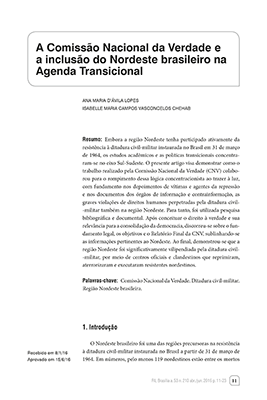E os negros? Onde estão os negros? Antirracismo patrimonial e os quilombos
Paulo Fernando Soares Pereira
Resumo
Com base na análise do atual panorama do tombamento do patrimônio quilombola no Brasil – quais e quantos são os processos, de onde vieram e o que objetivaram –, este artigo tem o propósito de discutir as possibilidades de promover medidas antirracistas baseadas no exemplo da patrimonialização dos sítios com reminiscências históricas dos antigos quilombos, nos termos do art. 216, § 5º, da Constituição brasileira. Para isso, parte-se da premissa de que o contraponto do racismo é o antirracismo, de modo que é necessário falar sobre o racismo e combatê-lo, encarando-o como problema público que permeia a sociedade e o Estado brasileiro, pois o escravismo, que perdurou nacionalmente durante quase quatro séculos, após 1888 manteve grande parte de seus elementos negativos na República instalada após 1889. Por meio da revisão de literatura, documentos e processos administrativos em andamento no IPHAN, o trabalho conclui que o tombamento quilombola não é mera retórica constitucional simbólica, mas verdadeiro reconhecimento da história e da resistência quilombola ao processo opressivo da escravidão.
Palavras-chave
Constituição. Quilombos. Reconhecimento. Patrimonialização. Antirracismo.
Título, resumo e palavras-chave em inglês
And the blacks? Where are the blacks? Blackness and cultural heritage: anti-racist heritage from the quilombos
Starting from the current scenario on the listing of quilombola heritage in Brazil – which ones and how many are the cases, where did they come from and what did they aim for –, the article discusses the possibilities of promoting anti-racist policies based on the creation of heritage sites from the reminiscences of the old quilombos, under the terms of art. 216, § 5, of the Brazilian Constitution. The premise is that the opposite of racism is anti-racism, that is, it is necessary to speak and fight racism, facing it as a general problem that permeates Brazilian society and the State, because of slavery, which lasted for almost four centuries until 1888 and kept a large part of its negative elements in the Republic that began in 1889. With a systematic literature review, documents, and administrative processes underway with IPHAN, the work concludes that the listing of quilombos is not merely a constitutional symbolism, but a true recognition and inclusion of the history and memory of the quilombola resistance to the oppression of slavery.
Constitution. Quilombos. Recognition. Heritage. Anti-racism.
Como citar este artigo
(ABNT)
PEREIRA, Paulo Fernando Soares. E os negros? Onde estão os negros?: antirracismo patrimonial e os quilombos. Revista de Informação Legislativa: RIL, Brasília, DF, v. 57, n. 227, p. 131-153, jul./set. 2020. Disponível em: https://www12.senado.leg.br/ril/edicoes/57/227/ril_v57_n227_p131
(APA)
Pereira, P. F. S. (2020). E os negros? Onde estão os negros?: antirracismo patrimonial e os quilombos. Revista de Informação Legislativa: RIL, 57(227), 131-153. Recuperado de https://www12.senado.leg.br/ril/edicoes/57/227/ril_v57_n227_p131
